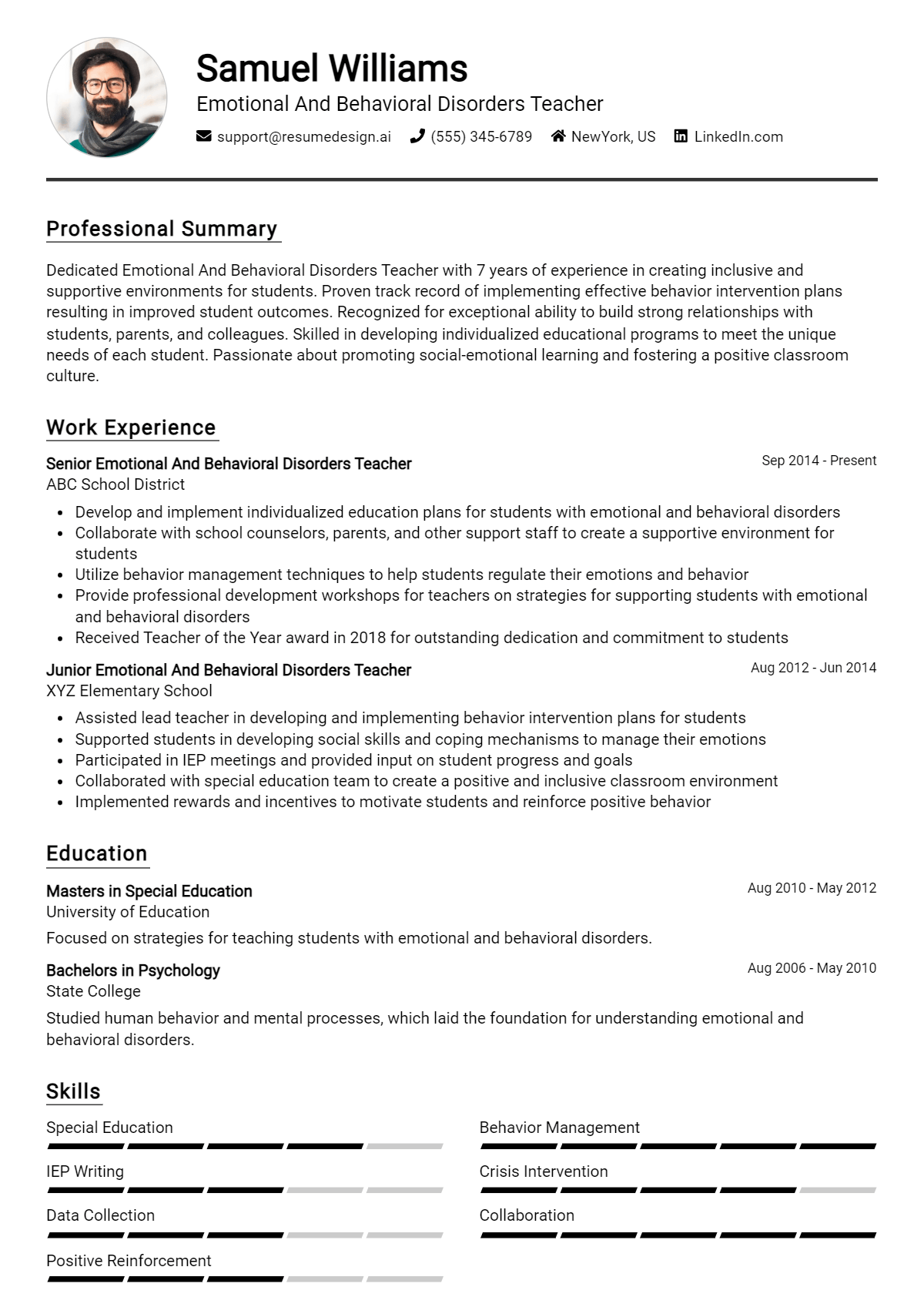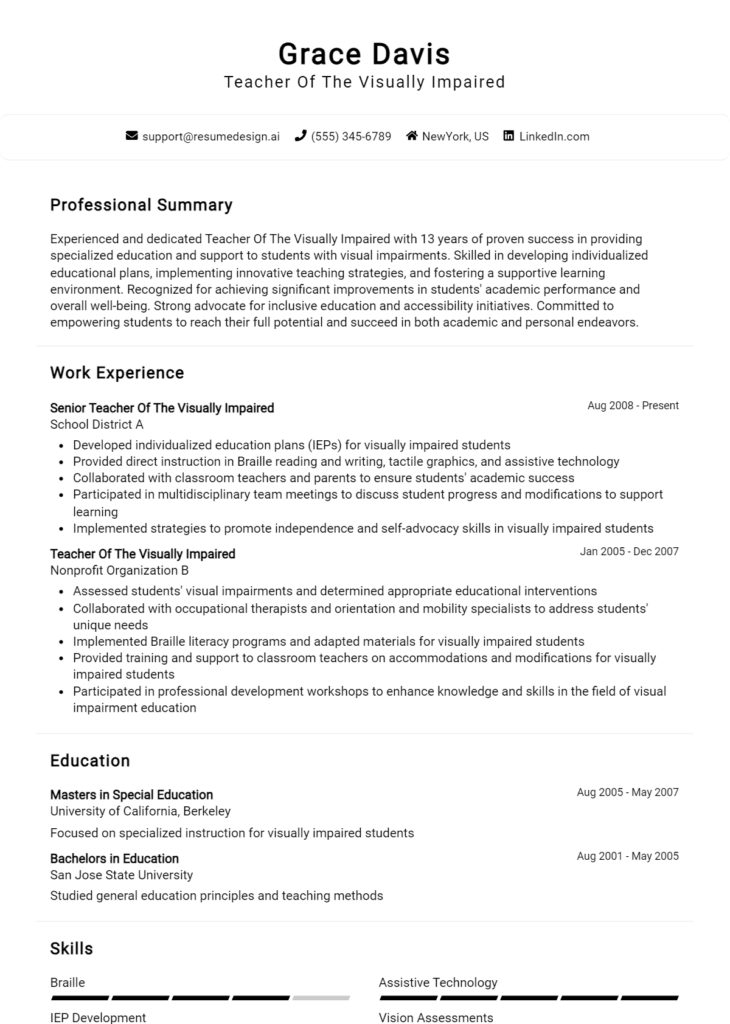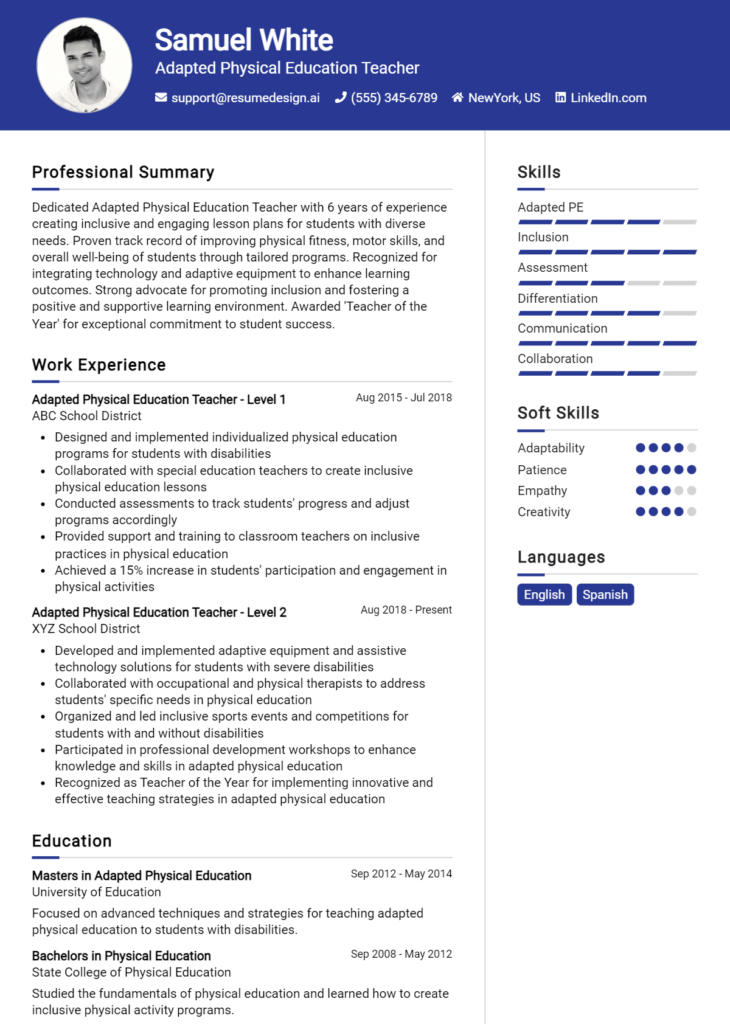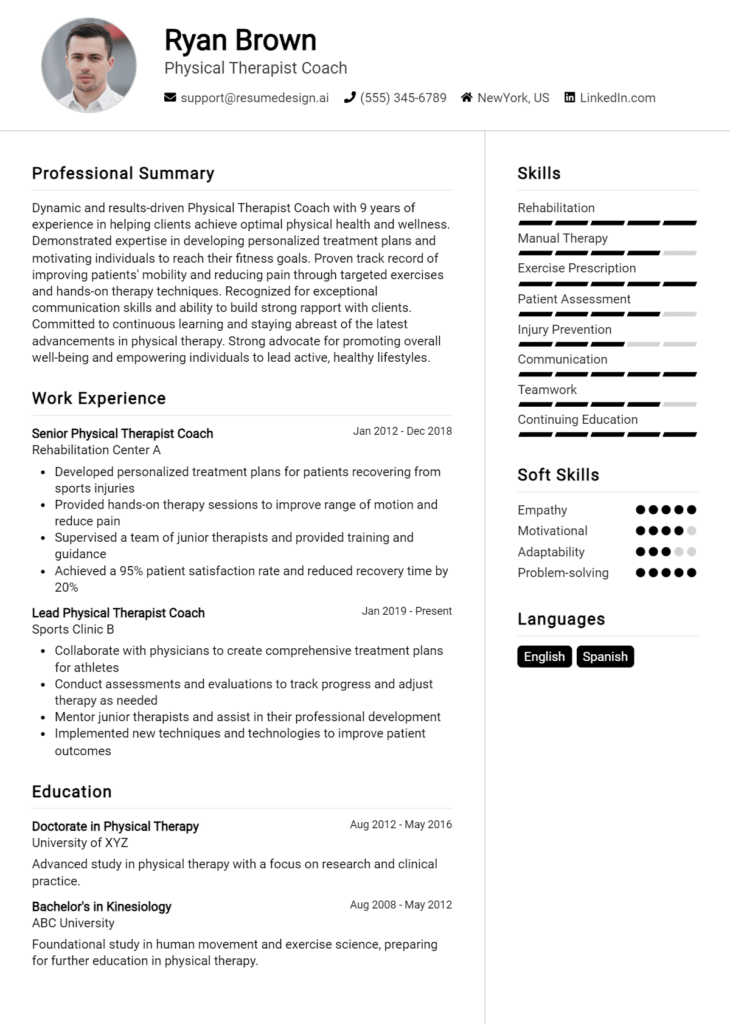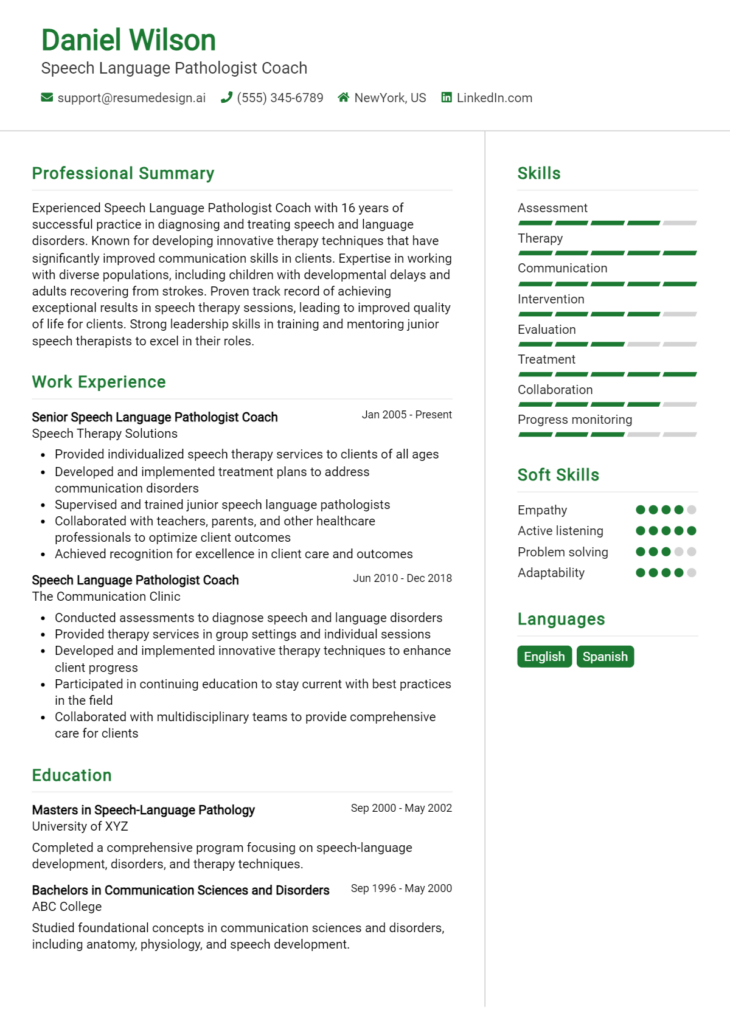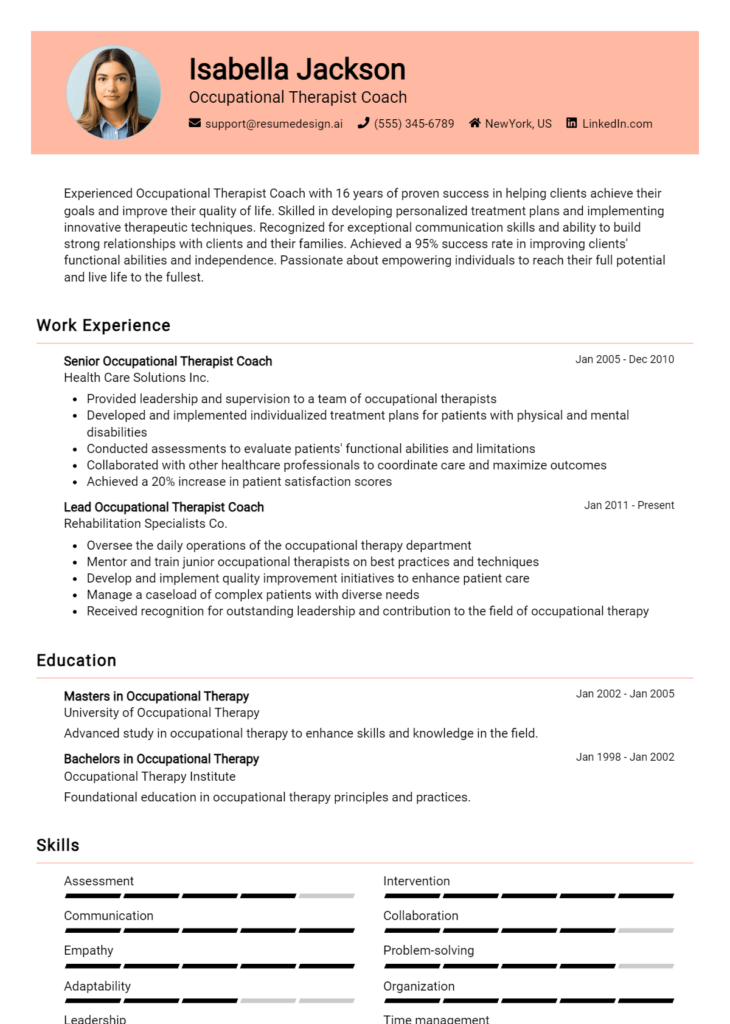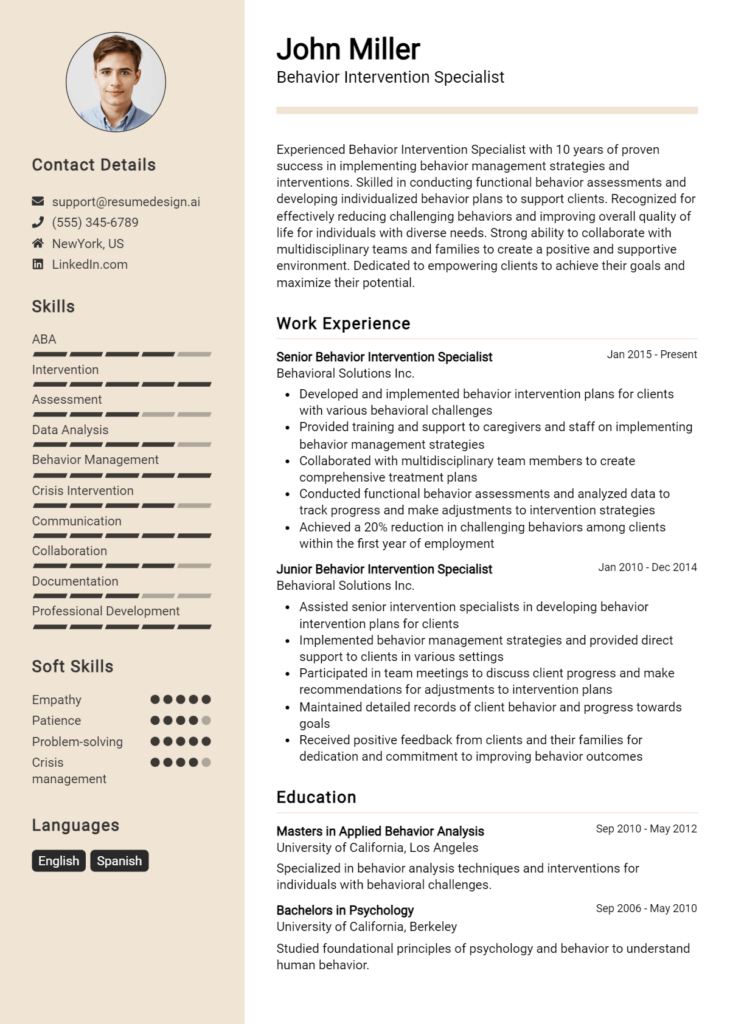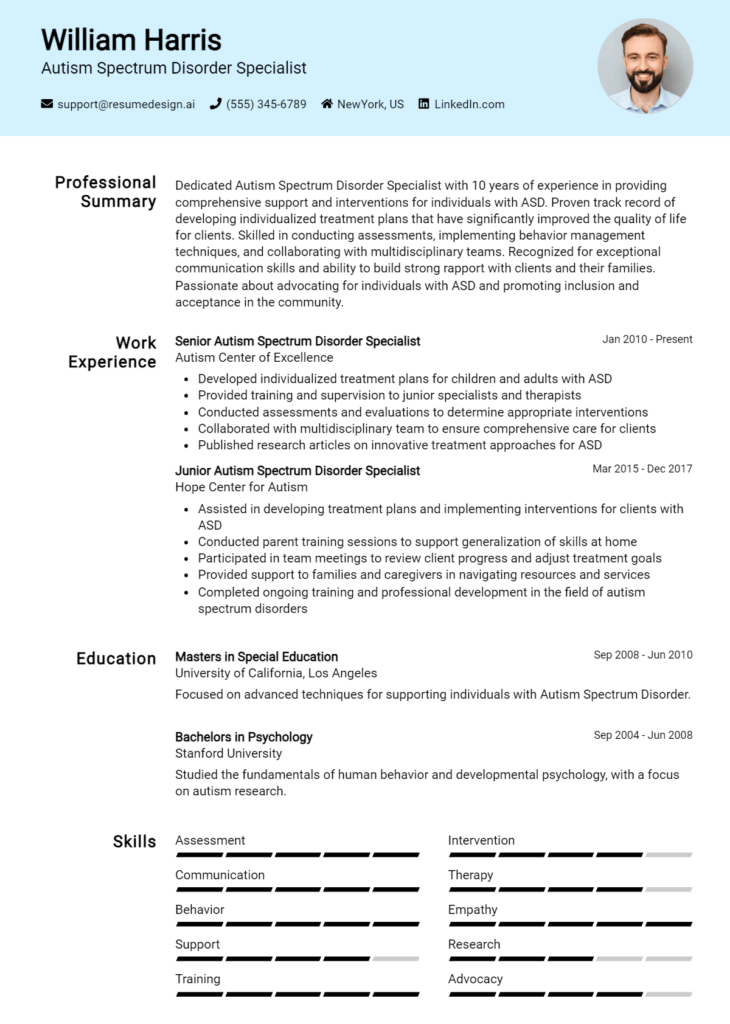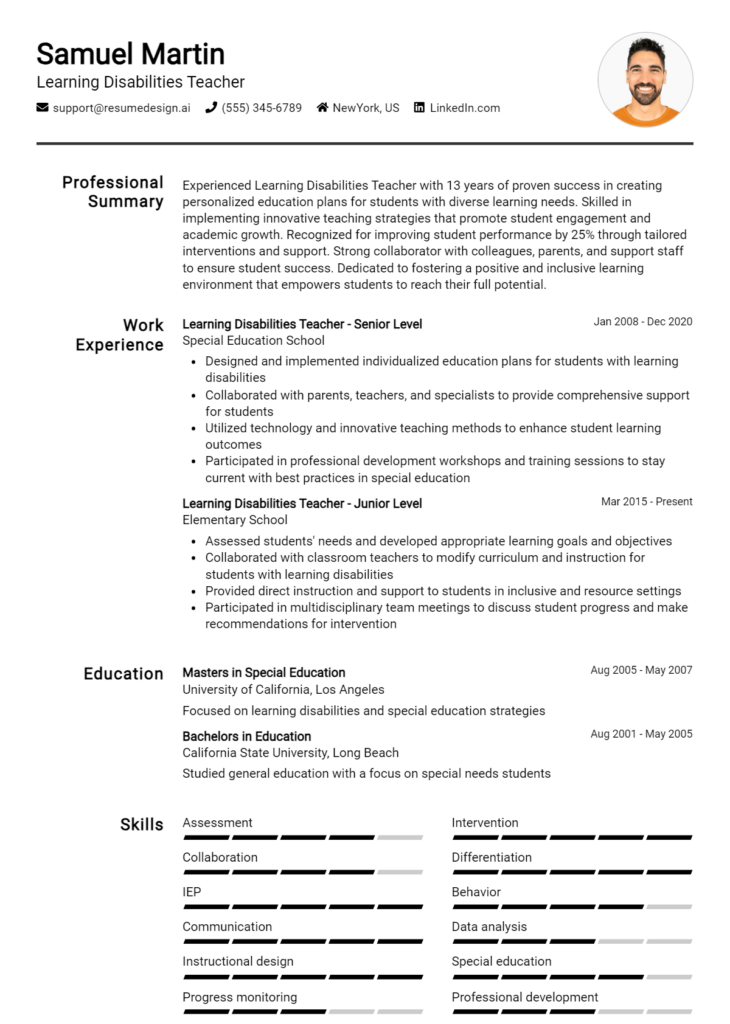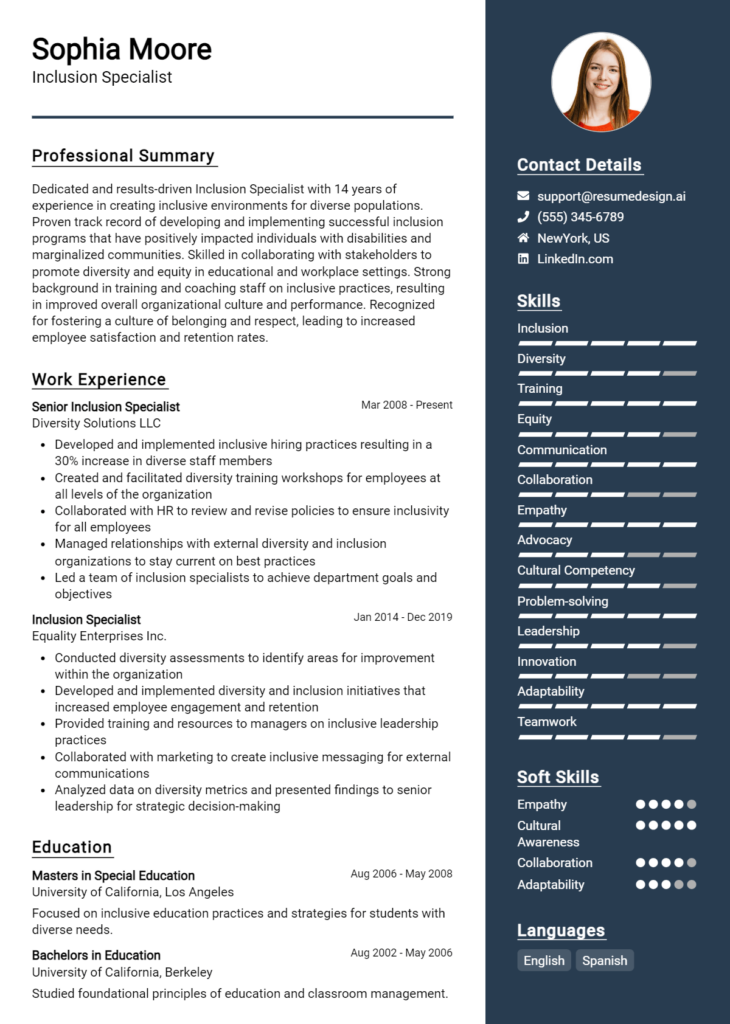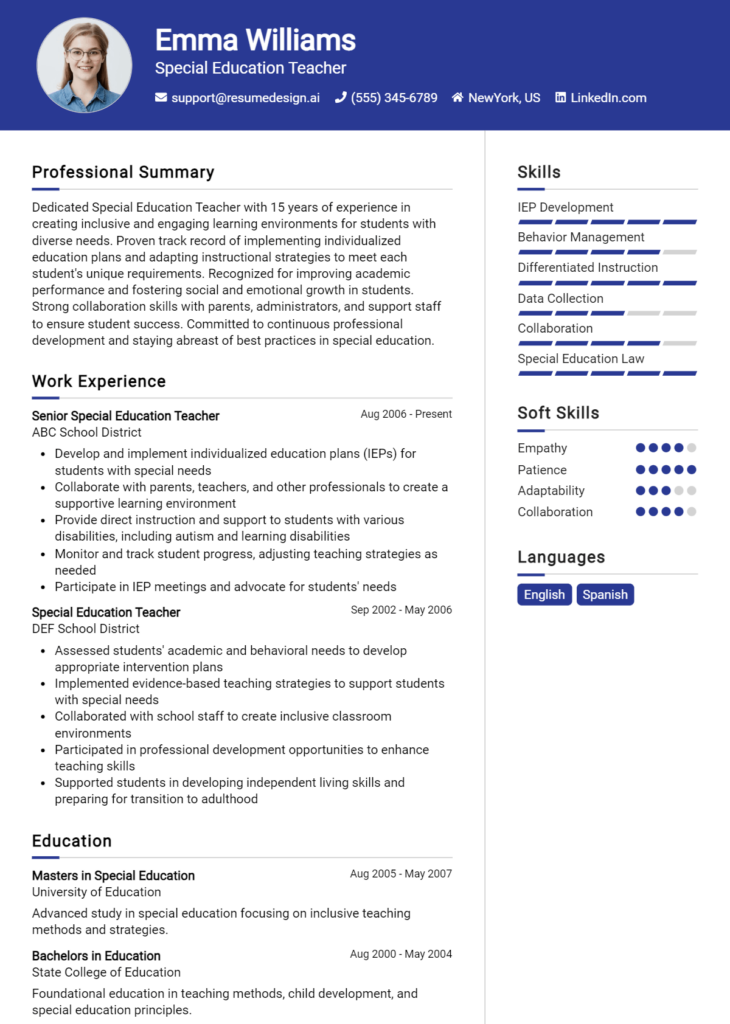Emotional and Behavioral Disorders Teacher Core Responsibilities
An Emotional and Behavioral Disorders Teacher plays a crucial role in supporting students with emotional and behavioral challenges, facilitating their academic and personal growth. Key responsibilities include developing individualized education plans (IEPs), collaborating with multidisciplinary teams, and implementing behavioral interventions. Essential skills encompass technical knowledge of special education laws, operational strategies for classroom management, and strong problem-solving abilities to address diverse student needs. A well-structured resume highlighting these qualifications is vital for demonstrating how the teacher contributes to the organization's overall goals of inclusion and effective education.
Common Responsibilities Listed on Emotional and Behavioral Disorders Teacher Resume
- Develop and implement individualized education plans (IEPs) for students.
- Monitor and assess student progress and adjust interventions as needed.
- Collaborate with parents, teachers, and support staff to create a cohesive support system.
- Conduct classroom and behavioral management strategies to promote positive behavior.
- Provide direct instruction in core academic subjects and social skills.
- Maintain accurate records of student behavior and academic progress.
- Facilitate group therapy sessions and social skills training.
- Participate in professional development activities to stay current with best practices.
- Advocate for the needs of students with emotional and behavioral disorders.
- Communicate effectively with stakeholders regarding student needs and progress.
- Implement crisis intervention strategies as necessary.
- Engage in reflective practice to improve teaching strategies and student outcomes.
High-Level Resume Tips for Emotional and Behavioral Disorders Teacher Professionals
A well-crafted resume is crucial for Emotional and Behavioral Disorders Teacher professionals, as it often serves as the first impression a candidate makes on potential employers. In a field that requires a unique combination of education, empathy, and specialized skills, your resume must effectively showcase not only your qualifications but also your achievements and passion for helping students with emotional and behavioral challenges. This guide will provide practical and actionable resume tips specifically tailored for Emotional and Behavioral Disorders Teacher professionals, ensuring that you present yourself as a strong candidate in this specialized area of education.
Top Resume Tips for Emotional and Behavioral Disorders Teacher Professionals
- Tailor your resume to each job description by incorporating relevant keywords and phrases to demonstrate alignment with the employer's needs.
- Highlight specific experiences working with students facing emotional and behavioral challenges, including strategies you employed and their outcomes.
- Quantify your achievements whenever possible, such as improvements in student behavior or academic performance, to provide measurable evidence of your impact.
- Emphasize industry-specific skills, such as crisis intervention, behavior modification techniques, and knowledge of special education laws.
- Include relevant certifications and training, such as those in trauma-informed care or positive behavioral interventions and supports (PBIS).
- Utilize a clear and professional format, ensuring your resume is easy to read and visually appealing to capture attention quickly.
- Incorporate examples of collaboration with other educators, parents, and support staff to demonstrate your ability to work in a team-oriented environment.
- Showcase your commitment to ongoing professional development, including workshops, conferences, and additional coursework related to emotional and behavioral disorders.
- Make sure to include a strong summary statement at the top of your resume that encapsulates your teaching philosophy and dedication to supporting students with emotional and behavioral needs.
By implementing these tips, you can significantly increase your chances of landing a job in the Emotional and Behavioral Disorders Teacher field. A well-structured resume that showcases your relevant experiences, skills, and achievements will not only help you stand out to potential employers but also reflect your commitment to making a positive impact in the lives of students facing emotional and behavioral challenges.
Why Resume Headlines & Titles are Important for Emotional and Behavioral Disorders Teacher
In the competitive field of education, particularly for specialized roles such as an Emotional and Behavioral Disorders Teacher, crafting an effective resume headline or title is crucial for standing out. A strong headline acts as the first impression for hiring managers, summarizing a candidate's key qualifications and setting the tone for the rest of the resume. It should be concise, relevant, and directly related to the position being applied for, allowing the reader to quickly grasp the candidate's strengths and suitability for the role. By encapsulating qualifications in one impactful phrase, a well-crafted headline can immediately grab attention and encourage further exploration of the resume.
Best Practices for Crafting Resume Headlines for Emotional and Behavioral Disorders Teacher
- Keep it concise—aim for one to two impactful phrases.
- Make it role-specific—highlight your expertise in emotional and behavioral disorders.
- Use action verbs to convey a sense of accomplishment and competence.
- Incorporate relevant keywords that align with the job description.
- Focus on unique strengths or experiences that set you apart from other candidates.
- Avoid jargon—use clear and simple language that is easy to understand.
- Tailor each headline to the specific position you are applying for.
- Consider including quantifiable achievements or certifications related to the role.
Example Resume Headlines for Emotional and Behavioral Disorders Teacher
Strong Resume Headlines
Compassionate Emotional and Behavioral Disorders Teacher with 5+ Years of Experience in Special Education
Dynamic Educator Specialized in Developing Individualized Learning Plans for At-Risk Students
Dedicated Teacher with Proven Success in Creating Supportive Learning Environments for Emotional and Behavioral Needs
Weak Resume Headlines
Teacher Looking for a Job
Education Professional
The strong headlines are effective because they clearly articulate the candidate’s qualifications and specific focus on emotional and behavioral disorders, immediately providing relevant context to the hiring manager. They demonstrate an understanding of the role and convey a sense of professionalism and commitment. In contrast, the weak headlines fail to impress because they are vague and generic, offering no insight into the candidate's abilities or focus area. This lack of specificity makes it challenging for hiring managers to gauge the candidate's fit for the specialized role, resulting in missed opportunities.
Writing an Exceptional Emotional and Behavioral Disorders Teacher Resume Summary
Creating a standout resume summary is essential for an Emotional and Behavioral Disorders Teacher, as it serves as the first impression for hiring managers. A well-crafted summary succinctly captures key skills, relevant experience, and notable accomplishments, allowing candidates to quickly convey their suitability for the role. In a competitive job market, a strong summary can differentiate a candidate by highlighting their unique strengths and commitment to supporting students with emotional and behavioral challenges. It should be concise, impactful, and tailored specifically to the job for which the candidate is applying.
Best Practices for Writing a Emotional and Behavioral Disorders Teacher Resume Summary
- Quantify achievements: Use specific numbers or outcomes to illustrate the impact of your work.
- Highlight relevant skills: Focus on skills that are directly related to working with students with emotional and behavioral disorders.
- Tailor the summary: Customize the summary for each job application by aligning it with the job description.
- Use action verbs: Start sentences with dynamic verbs to convey confidence and proactivity.
- Showcase certifications: Mention relevant certifications that enhance your credibility as a teacher.
- Keep it concise: Aim for 3-5 sentences that deliver maximum information in a brief format.
- Emphasize collaboration: Highlight your ability to work with parents, other educators, and support staff.
- Reflect empathy and understanding: Convey your commitment to understanding and addressing the needs of your students.
Example Emotional and Behavioral Disorders Teacher Resume Summaries
Strong Resume Summaries
Dedicated Emotional and Behavioral Disorders Teacher with over 7 years of experience implementing individualized education plans (IEPs) that resulted in a 30% improvement in student behavior and academic performance, fostering a supportive learning environment for diverse learners.
Compassionate educator with a proven track record of effectively managing classroom behavior, achieving a 90% success rate in reducing disciplinary referrals among students with emotional and behavioral challenges through targeted interventions and positive reinforcement techniques.
Results-driven teacher specializing in emotional and behavioral disorders, recognized for developing innovative curriculum adaptations that increased student engagement by 40%, while collaborating closely with parents and mental health professionals to ensure holistic support.
Weak Resume Summaries
Experienced teacher who works with students with behavioral issues and tries to help them do better in school.
Educator with some background in emotional and behavioral disorders, looking for a job where I can help kids.
The strong resume summaries are effective because they incorporate quantifiable results, specific skills, and relevant experiences that demonstrate the candidate’s impact on students’ lives. They convey a sense of accomplishment and expertise that resonates with hiring managers. In contrast, the weak summaries lack detail and specificity, making them seem generic and unconvincing. They fail to highlight any measurable outcomes or unique qualifications, thereby diminishing the candidate's appeal.
Work Experience Section for Emotional and Behavioral Disorders Teacher Resume
The work experience section of an Emotional and Behavioral Disorders Teacher resume is critical as it serves as a platform to showcase a candidate's technical skills, leadership capabilities, and their ability to provide high-quality educational experiences for students with emotional and behavioral challenges. This section not only highlights the specific experiences that have shaped a teacher's approach but also quantifies achievements to demonstrate effectiveness. Aligning this experience with industry standards is essential for presenting a compelling case to potential employers, making it easier to understand the candidate's impact in previous roles.
Best Practices for Emotional and Behavioral Disorders Teacher Work Experience
- Utilize action verbs to convey strong leadership and initiative.
- Quantify achievements with specific metrics (e.g., improved student outcomes by 30%).
- Highlight collaboration with multidisciplinary teams to support student needs.
- Include relevant certifications or specialized training in behavior management.
- Focus on specific programs or interventions that were implemented successfully.
- Demonstrate adaptability and innovative teaching strategies for diverse learners.
- Emphasize communication skills with students, parents, and staff.
- Showcase contributions to school-wide initiatives or community outreach programs.
Example Work Experiences for Emotional and Behavioral Disorders Teacher
Strong Experiences
- Developed and implemented a behavioral intervention program that reduced classroom disruptions by 40%, leading to a more conducive learning environment.
- Collaborated with a team of therapists and educational psychologists to create individualized education plans (IEPs) for 15 students, resulting in a 25% increase in student engagement.
- Trained and mentored new staff on effective behavior management techniques, enhancing team effectiveness and improving overall student outcomes in the classroom.
- Facilitated weekly workshops for parents on behavioral strategies, receiving positive feedback from 90% of participants regarding their child's progress.
Weak Experiences
- Taught students with emotional issues.
- Worked with other teachers occasionally.
- Participated in meetings about student behavior.
- Helped students improve their behavior sometimes.
The examples provided illustrate the difference between strong and weak experiences effectively. Strong experiences are detailed, quantifiable, and demonstrate specific outcomes and collaboration, showcasing a proactive and impactful approach to teaching. In contrast, weak experiences are vague and lack specificity, failing to highlight the candidate's true contributions or achievements in the role. This distinction is essential for making a resume stand out in a competitive job market.
Education and Certifications Section for Emotional and Behavioral Disorders Teacher Resume
The education and certifications section of an Emotional and Behavioral Disorders Teacher resume is crucial in establishing the candidate's qualifications and suitability for the role. This section not only showcases the candidate's academic background but also highlights industry-relevant certifications and ongoing professional development efforts. By providing relevant coursework, specialized training, and certifications, candidates can significantly enhance their credibility, demonstrating a commitment to continuous learning and a deep understanding of the complexities involved in teaching students with emotional and behavioral disorders. This alignment with the job role is essential for standing out in a competitive job market.
Best Practices for Emotional and Behavioral Disorders Teacher Education and Certifications
- Include degrees in special education, psychology, or related fields that directly pertain to emotional and behavioral disorders.
- Highlight relevant certifications, such as Board Certified Behavior Analyst (BCBA) or Certified Emotional Disturbance Specialist.
- List any specialized training or workshops attended that focus on behavioral management and intervention strategies.
- Provide details on coursework that covers topics like child psychology, behavior analysis, and inclusive education practices.
- Emphasize any advanced degrees or endorsements, such as a Master's in Special Education with a focus on emotional and behavioral disorders.
- Include professional development activities that demonstrate an ongoing commitment to improving skills and knowledge in the field.
- Use specific terminology and industry-recognized credentials to enhance relevance and credibility.
- Avoid listing outdated or irrelevant qualifications that do not pertain to the current educational landscape.
Example Education and Certifications for Emotional and Behavioral Disorders Teacher
Strong Examples
- Master of Education in Special Education, University of State, 2021
- Board Certified Behavior Analyst (BCBA), 2022
- Certificate in Trauma-Informed Care, National Institute for Trauma and Loss in Children, 2023
- Relevant Coursework: Behavioral Interventions for Children with Emotional Disturbances, Classroom Management Strategies, and Advanced Child Psychology.
Weak Examples
- Bachelor of Arts in History, University of State, 2010
- Certification in Basic First Aid, 2019
- General Education Teaching License, 2015
- Coursework in Adult Learning Principles, 2020
The strong examples illustrate relevant educational qualifications and certifications that directly align with the needs of an Emotional and Behavioral Disorders Teacher, showcasing specialized knowledge and a commitment to the field. In contrast, the weak examples reflect qualifications that are outdated or unrelated to the specific requirements of this teaching role, thereby diminishing the candidate's perceived expertise and suitability for positions focused on emotional and behavioral disorders.
Top Skills & Keywords for Emotional and Behavioral Disorders Teacher Resume
As an Emotional and Behavioral Disorders Teacher, having a well-crafted resume that highlights relevant skills is crucial for standing out in the job market. The ability to effectively manage classroom dynamics, foster emotional growth, and implement behavioral strategies is essential in supporting students with diverse needs. Employers seek candidates who not only possess the necessary knowledge but also demonstrate strong interpersonal and communication skills. By showcasing a blend of both hard and soft skills, you can provide a comprehensive picture of your capabilities, making you a desirable candidate for this impactful role.
Top Hard & Soft Skills for Emotional and Behavioral Disorders Teacher
Soft Skills
- Empathy
- Active Listening
- Patience
- Conflict Resolution
- Adaptability
- Communication
- Team Collaboration
- Problem-Solving
- Time Management
- Positive Reinforcement
Hard Skills
- Knowledge of Behavioral Intervention Plans (BIPs)
- Familiarity with Individualized Education Programs (IEPs)
- Crisis Intervention Techniques
- Data Collection and Analysis
- Classroom Management Strategies
- Familiarity with Special Education Laws and Regulations
- Behavior Assessment Tools
- Lesson Planning for Diverse Learners
- Instructional Technology Proficiency
- Knowledge of Mental Health Resources
Incorporating these skills into your resume will not only showcase your qualifications but also demonstrate your commitment to fostering a supportive learning environment. Additionally, highlighting relevant work experience will further strengthen your application, showing potential employers how your background aligns with the needs of their students.
Stand Out with a Winning Emotional and Behavioral Disorders Teacher Cover Letter
Dear [Hiring Manager's Name],
I am writing to express my interest in the Emotional and Behavioral Disorders Teacher position at [School or Institution Name], as advertised on [where you found the job listing]. With a strong educational background in special education and hands-on experience working with students who have emotional and behavioral disorders, I am eager to contribute to your team and help foster a positive learning environment for all students. My passion for teaching and my commitment to supporting diverse learners align perfectly with your school's mission to provide inclusive and effective education.
During my time at [Previous School or Institution], I successfully designed and implemented individualized education plans (IEPs) that addressed the unique needs of each student. My approach integrates evidence-based strategies and a trauma-informed perspective, which has proven effective in helping students regulate their emotions and improve their academic performance. I believe in creating a safe and supportive classroom atmosphere where students feel valued and understood, enabling them to engage more fully in their learning. Through collaboration with fellow educators, parents, and support staff, I have developed comprehensive support systems that empower students to overcome challenges and achieve their goals.
I am particularly impressed by [School or Institution Name]'s commitment to [specific program, initiative, or value related to emotional and behavioral support], and I am excited about the opportunity to contribute to such an inspiring environment. I am confident that my skills in behavior management, crisis intervention, and positive reinforcement will be an asset to your team. I look forward to the possibility of discussing how my background, skills, and enthusiasms align with the needs of your students and the goals of your school.
Thank you for considering my application. I hope to bring my expertise and passion for teaching to [School or Institution Name] and look forward to the opportunity for an interview. Please feel free to contact me at [Your Phone Number] or [Your Email Address] to arrange a convenient time to discuss my candidacy further.
Sincerely,
[Your Name]
Common Mistakes to Avoid in a Emotional and Behavioral Disorders Teacher Resume
When applying for a position as an Emotional and Behavioral Disorders (EBD) Teacher, crafting a strong resume is crucial to stand out in a competitive job market. However, many candidates make common mistakes that can hinder their chances of securing an interview. Understanding these pitfalls can help you create a compelling resume that effectively showcases your qualifications, skills, and experience in working with students who have emotional and behavioral challenges.
Generic Objective Statement: Using a vague or generic objective statement fails to highlight your specific intentions and can make your resume blend in with others. Tailor your objective to reflect your passion for teaching EBD students.
Lack of Specific Experience: Omitting detailed descriptions of your relevant experience can diminish your resume's impact. Be specific about the educational settings you've worked in and the strategies you've implemented to support students with emotional and behavioral disorders.
Ignoring Relevant Certifications: Failing to mention any specialized certifications or training related to EBD can be a significant oversight. Ensure that you list any credentials, such as special education certifications, that demonstrate your qualifications for the role.
Neglecting Soft Skills: EBD teaching requires strong interpersonal and communication skills. If you focus solely on technical skills and neglect to mention your ability to build relationships and manage classroom dynamics, you may miss an opportunity to highlight essential qualities.
Inconsistent Formatting: An unorganized or inconsistent format can make your resume difficult to read. Use a clear structure with consistent font sizes, bullet points, and headings to improve readability and professionalism.
Overlooking Data and Achievements: Failing to include quantifiable achievements can weaken your resume. Highlight specific successes, such as improvements in student behavior or academic performance, using metrics to demonstrate your impact.
Using Jargon or Technical Language: While it may be tempting to use educational jargon, this can alienate some readers. Use clear, concise language that effectively communicates your experience and skills without assuming prior knowledge.
Not Tailoring for Each Application: Sending out a one-size-fits-all resume can reduce your chances of being noticed. Tailor your resume for each job application by emphasizing the most relevant experience and skills that align with the specific job description.
Conclusion
As an Emotional and Behavioral Disorders Teacher, your role is pivotal in supporting students who face emotional and behavioral challenges. Key responsibilities include developing individualized education plans (IEPs), implementing effective teaching strategies tailored to each student's unique needs, and collaborating with parents and other professionals to foster a supportive learning environment. Your expertise not only helps students achieve academic success but also promotes their social and emotional well-being.
To excel in this demanding field, it's essential to present a compelling resume that highlights your qualifications, experience, and the impact you've made on your students' lives. A well-crafted resume can set you apart from other candidates and showcase your dedication to this vital role.
Now is the time to review your Emotional and Behavioral Disorders Teacher resume. Ensure it accurately reflects your skills and achievements. To assist you in this process, consider utilizing various tools available to enhance your resume:
- Explore a range of resume templates tailored for educators.
- Use the resume builder to create a polished and professional document effortlessly.
- Check out resume examples for inspiration and guidance on formatting and content.
- Don't forget to craft a strong first impression with our cover letter templates that complement your resume.
Take action today and make the necessary updates to your resume, ensuring you are well-prepared to make a positive impact in the lives of your students.

